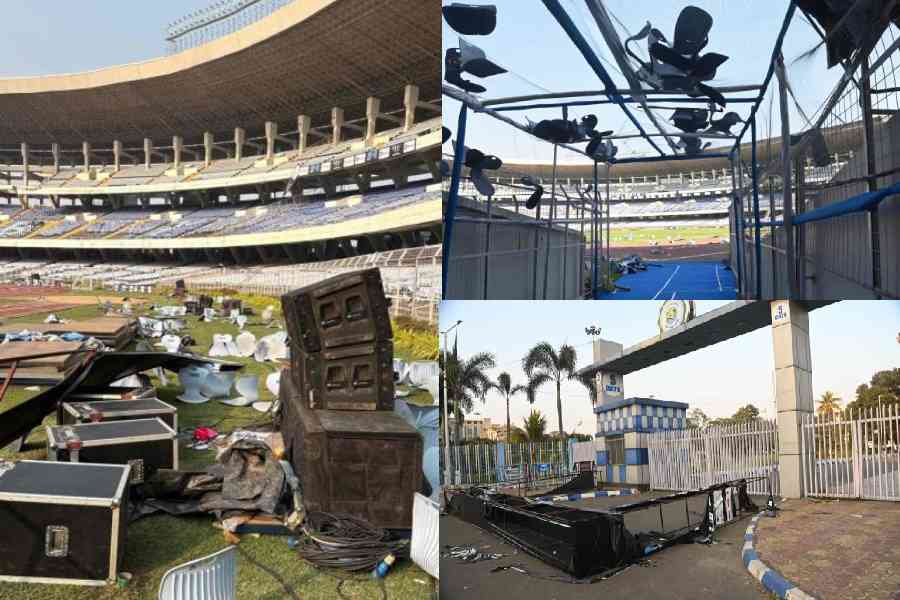Dozens of houses have collapsed in two villages, one in Jammu and the other in Kashmir, because of land subsidence and mudslides that residents have linked to two high-profile road and railway projects.
People at Duksar Dal village in Jammu, where land subsidence has caused over dozen homes to cave in, blame the blasts being carried out to construct mountain tunnels for the Udhampur-Baramulla rail link that will connect the Valley with the country’s rail grid.
Villagers at Rezan in Sonamarg, Kashmir, where mudslides destroyed about two dozen homes and shops on Sunday evening, are pointing a finger at one of the two tunnels being built to provide an all-weather road from the Valley to Ladakh.
Sarpanch Ishfaq Ahmad Raina said that officials had a few months ago reassured the worried villagers against the possibility of any such disaster.
The Duksar and Rezan disasters have come days after dozens of houses collapsed or developed cracks in Jammu’s Doda district, forcing hundreds to flee their homes and triggering fears of a Joshimath-like emergency.
While water seepage has been suggested as a possible reason, a link with under-construction dams has not been ruled out. People at Duksar, 43km from the Ramban district headquarters, said a crater had developed in the village a few days ago.
“It spread to a diameter of around half a kilometre, damaging 15 houses and sinking a road connecting dozens of villages in the Gool area. There’s panic — we fear more damage in the coming days,” a former village sarpanch, Raqeeb Wani, told The Telegraph.
Wani called it a “manmade” disaster, linking it to the construction of two railway tunnels downhill. He said the 3km stretch of the railway project between Sangaldan and Chaddi in the area lay mostly underground.
“There is fear of more such incidents as the continuous blasting seems to have loosened the soil and made these mountains unstable. Luckily, there have been no casualties,” he said.
Wani added: “The last time we had such a disaster in the area was in Sangaldan a few years ago when an entire market caved in.”
Residents had blamed the Sangaldan crisis too on the railway project, which has been going on for years. Ramban deputy commissioner Musarat-ul-Islam, who visited the area on Monday, said “the 13 affected families” had been shifted to safer areas.
He said a team from the Geological Survey of India (GSI) would visit the area on Tuesday to ascertain the reasons behind the land subsidence. In Rezan, residents are blaming the 6.5km Z Morh tunnel being built to connect Gagangeer with Sonamarg.
The 14.2km Zoji La tunnel, being constructed some distance away, will connect Sonamarg with the Drass area of Kargil.
Sarpanch Raina said: “Several houses and shops have been completely destroyed. The mudslide was moving at a very slow pace, which allowed families to shift to safer places. Had it happened suddenly, nobody would have survived.”
He said the villagers had warned officials about an impending disaster several months ago.
“There were fissures in the hill because of relentless blasting. We filed several complaints after which officials told us they had brought a few foreign experts to the site and they had plugged the fissures. We had been feeling reassured since then,” he said.
“Another group of nearly two dozen houses can meet with the same fate. They (the company building the tunnel) have promised us compensation in case of any eventuality. They should come forward to help us as several people have been rendered homeless and jobless.”
Early in February, hundreds of villagers had fled their homes in the Thathri locality of Doda after their homes collapsed or developed cracks. Doda is part of the Chenab Valley, home to several big completed or under-construction hydroelectricity projects.
Local people in Doda say the disaster may be the result of sewage water seeping into the hills in the absence of a proper drainage system. But they have not ruled out the possibility of damage caused by the dams being built for hydroelectricity projects.
A team of GSI experts have visited the area but not made their report public yet.











